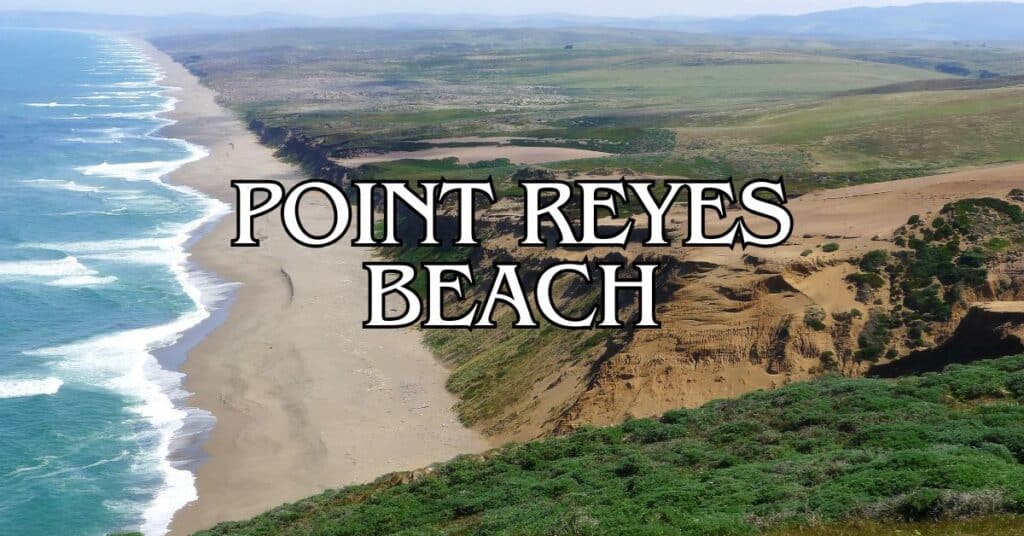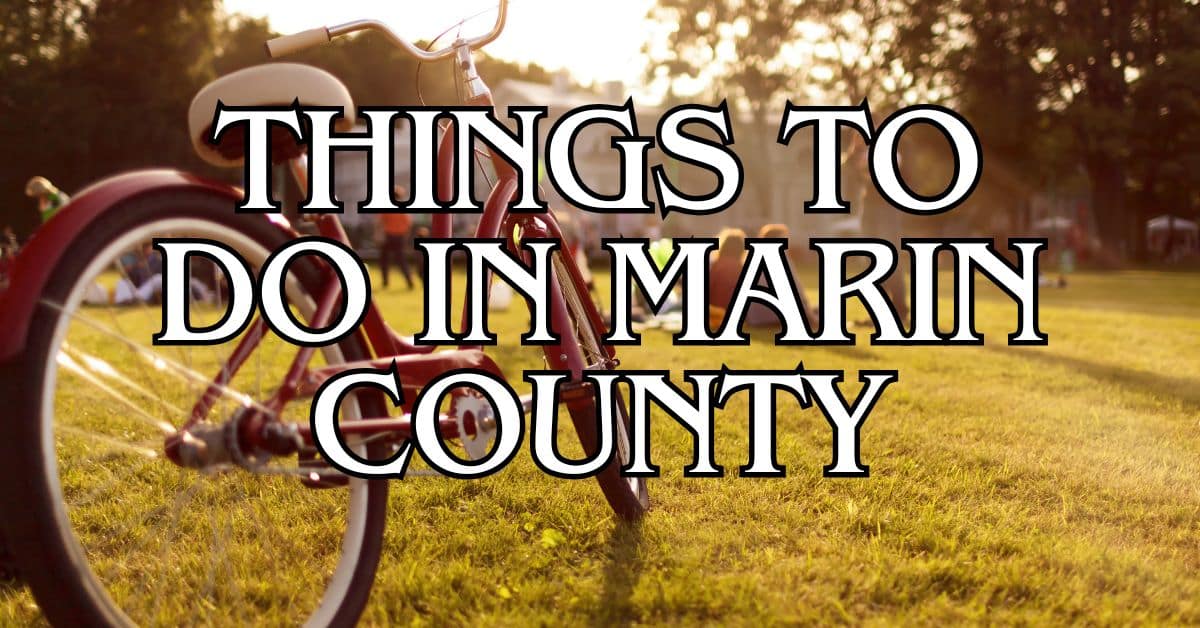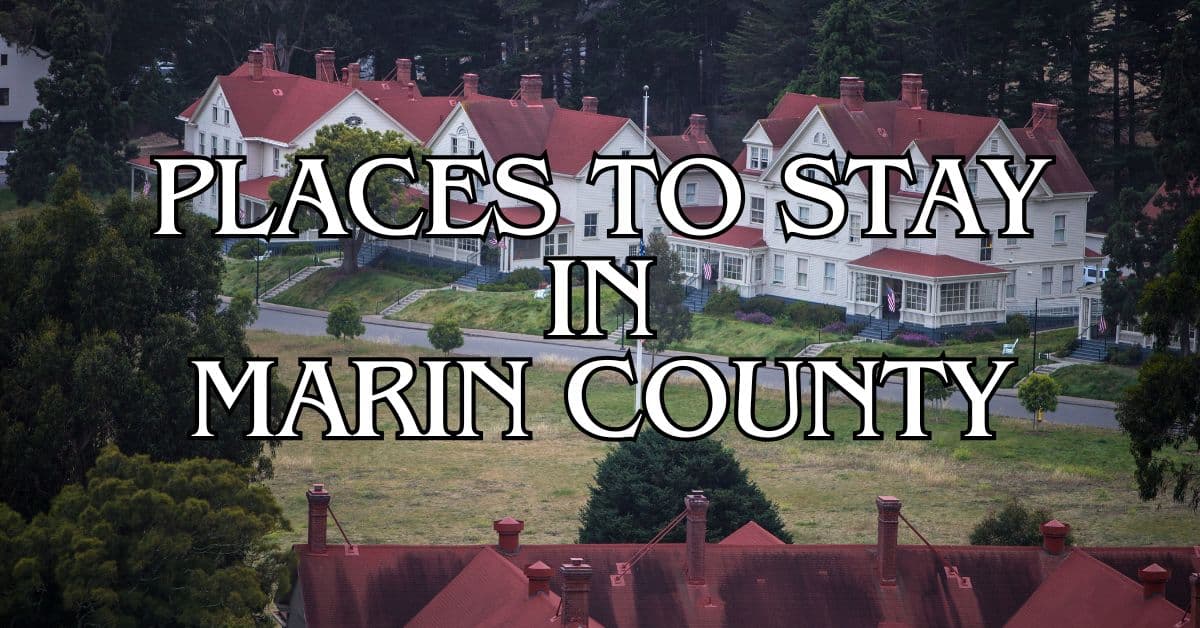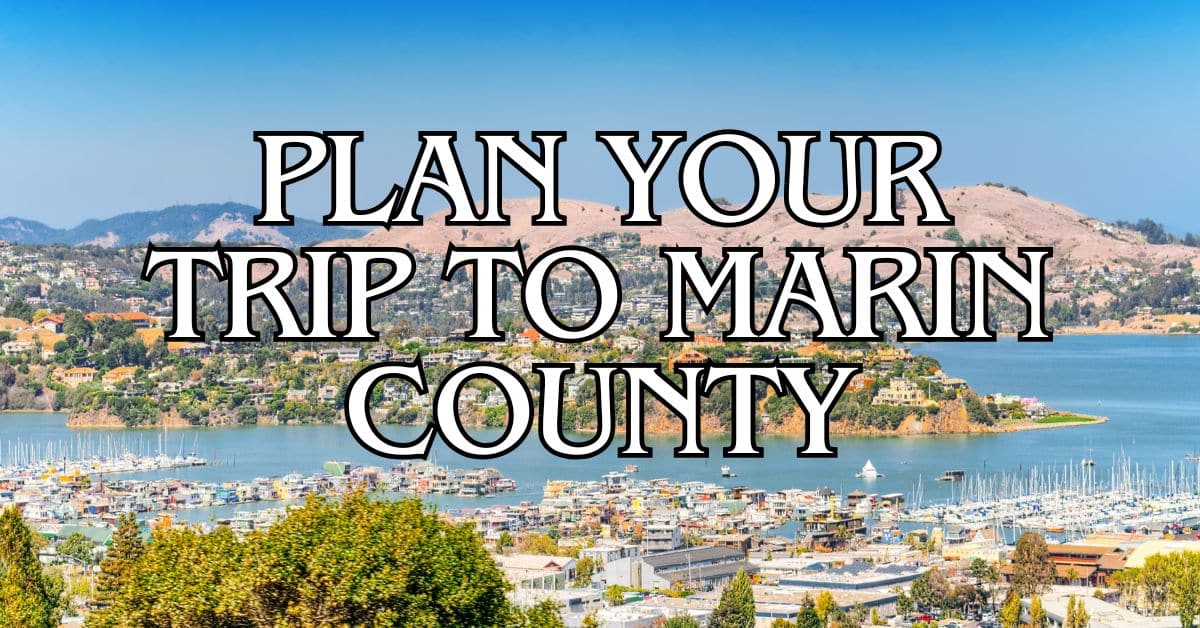Point Reyes Beach runs for more than 11 miles along Marin County’s coastline, stretching from Kehoe Beach to the Point Reyes Headlands. Locals call it Great Beach or Ten Mile Beach, and it’s about as wild and undeveloped as California beaches get. No crowds, no shops, just miles of soft sand, blue water, and waves that crash hard enough to drown out your thoughts. It’s the sort of place you can just stare at for hours, letting the world fade away.
You’ll find several ways to get onto the sand, but North Beach is probably the easiest place to start. As you wander, those rolling hills and ever-changing landscapes frame the beach in every direction. It’s got this rugged, untouched vibe that’s rare these days—a magnet for anyone who craves nature over noise.
Get a discount of 15% to 70% on accommodation in Marin County! Look for deals here:
Marin County Hotels, Apartments, B&Bs
But it’s not just about sitting and listening to the surf (though that’s a fine way to spend an afternoon). There are coastal trails to wander, tide pools to poke around in, and if you’re lucky or patient, you might spot a migrating whale offshore. The beach is a real escape from busy life. Just keep in mind, the waves here are no joke—powerful and unpredictable, so you’ll want to stay sharp if you’re anywhere near the water.
Overview of Point Reyes Beach (The Great Beach)
Point Reyes Beach is one of those places that feels almost endless, with 11 miles of untouched sand and dramatic surf. Some folks call it Great Beach or Ten Mile Beach, but whatever the name, it’s a stunner.
Location and Geography
This beach hugs the western edge of Point Reyes National Seashore in Marin County, California. It runs from the Point Reyes Headlands down south all the way up to Kehoe Beach. If you’re driving, you’ll find two main parking spots: North Beach and South Beach.
The landscape is wild. Some stretches are backed by steep cliffs, others by rolling dunes. The sand itself is wide and flat—perfect for long walks or just standing there, letting the wind tangle your hair. The currents and rip tides are intense, so swimming’s out, but the waves put on a show you won’t forget.
The weather? It’s a bit unpredictable. Fog loves to roll in during the summer, and winter swaps that out for clearer skies but some pretty fierce winds.
Significance Within Point Reyes National Seashore
Point Reyes Beach marks the untamed western edge of the 70,000+ acre Point Reyes National Seashore. Thanks to its protected status, it stays wild and undeveloped.
It’s more than just a pretty spot—it’s a vital home for shorebirds and marine life. In winter and spring, you might catch sandpipers and plovers darting about. And from December through April, gray whales pass by the Point Reyes Headlands, making it a favorite whale-watching spot.
There’s some deep history here too. Sir Francis Drake probably landed nearby in 1579, making this one of the earliest European landing sites on the West Coast (more on that here).
Great Beach stands apart from the park’s sheltered coves and grassy meadows—it’s all about raw, wild beauty.
Visiting Point Reyes Beach
The Pacific pounds this 11-mile stretch, and there’s plenty of room to roam. The beach is split into North and South sections, each with its own personality and access points.
Beach Access and Parking
You’ve got two main ways in: North Beach and South Beach. Both have their own parking lots right off Sir Francis Drake Boulevard. The lots aren’t huge, so if you’re coming on a summer weekend or holiday, get there early.
North Beach parking sits about halfway along the stretch, giving you good access to the middle. South Beach is down by the headlands, closer to the Point Reyes Headlands.
Parking’s free, and you’ll find info boards with maps and safety tips. On busy days, the lots fill up fast. If you strike out, Kehoe Beach is another option for northern access.
Essential Visitor Information
This isn’t a gentle, wading kind of beach. Sneaker waves, rip currents, and cold water are all real hazards. Never turn your back on the ocean, and honestly, don’t swim here—it’s just not safe.
There are restrooms at both parking areas, but no food or water. Bring whatever you’ll need for the day.
Fog and wind are pretty common. Dress in layers and bring something windproof—sunny mornings can flip to chilly afternoons in a blink.
Dogs are allowed, but only on leash and only in certain spots. Always check the latest rules at the Bear Valley Visitor Center before bringing your pup.
Cell service is spotty at best. Let someone know your plans if you’re heading out for a hike along the shore.
Point Reyes National Seashore and Surrounding Area
Point Reyes National Seashore covers about 80 miles of pristine California coast. It’s not just about beaches—there are forests, cliffs, and even some charming little towns nearby if you want a coffee or a real bed.
Highlights of the National Park
The park is a patchwork of ecosystems. Rocky shores hide tide pools full of weird and wonderful creatures, especially down at the south end of McClures Beach.
Hiking trails crisscross the area—some wind through coastal prairies and forests, others hug dramatic cliffs. Wildlife’s everywhere if you look: tule elk, harbor seals, and birds galore.
Winter and spring bring whales to the lighthouse area, and the historic lighthouse itself is worth a visit for the views alone.
The beaches range from wild and windy (like Great Beach) to smaller, sheltered coves. Each has its own vibe—some are better for beachcombing, some for (experienced) surfers.
Nearby Towns and Villages
Point Reyes Station is the main gateway. It’s small but has restaurants, bakeries, and shops where you can stock up. There’s a farmers market on Saturdays from spring to fall.
Inverness, tucked along Tomales Bay, offers waterfront dining and kayak rentals. The bay’s calm waters are a sharp contrast to the wild surf just over the hills.
Olema is a blink-and-you’ll-miss-it hamlet at the park’s southern entrance, with historic buildings and a few places to stay. It sits right where Sir Francis Drake Boulevard meets Highway 1.
Don’t want to drive? The West Marin Stagecoach runs public transit around here, connecting Point Reyes Station, Inverness, and other spots with the park’s main attractions.
Beach Activities and Recreation
There’s a lot more to do here than just stare at the waves (though that’s not a bad way to spend time). This 11-mile stretch offers all sorts of outdoor adventures, shifting with the seasons.
Hiking and Trails
Several good hiking trails connect to the Great Beach area. The Coastal Trail gives you access to the sand and some jaw-dropping cliff-top views. If you’re up for a tougher trek, the trail to Alamere Falls is a favorite—it ends with a waterfall spilling right onto the beach.
At low tide, you can walk for miles along the shore, watching the landscape change as you go. North Beach is especially good for long, sandy strolls.
Check tide charts before heading out—rising water can cut off your return route, especially near cliffs.
Bring sturdy shoes and dress in layers. The weather’s fickle, even on days that start sunny.
Wildlife Watching
This beach is a hotspot for wildlife. Gray whales cruise by during migration (December through April), with January and March usually the best times. Binoculars help, but sometimes you’ll spot their spouts with the naked eye.
Harbor seals and elephant seals haul out on certain sections for pupping season. The Chimney Rock area near South Beach is great for elephant seal viewing from December to March.
Shorebirds are always around. Watch for:
- Sanderlings chasing the waves
- Brown pelicans diving after fish
- Ospreys hunting along the cliffs
- Snowy plovers (they’re endangered, so give them space)
If you want fewer people and more critters, aim for early morning or late afternoon.
Water Activities
Honestly, water sports here are tricky. The surf is rough, the water’s cold, and rip currents are strong. Swimming’s not a good idea.
If you want to kayak, stick to Tomales Bay where it’s calmer. Outfits like Point Reyes Outdoors and Blue Waters Kayaking run guided trips—way safer and more fun than braving the open ocean solo.
Get a discount of 15% to 70% on accommodation in Marin County! Look for deals here:
Marin County Hotels, Apartments, B&Bs
Surfing is possible at North Beach, but only for folks who know what they’re doing. The waves are powerful and the currents are no joke.
Check the weather and talk to rangers before planning any water activities. The National Park Service keeps safety info updated for visitors.
Natural Features and Hazards
This place is gorgeous, but it’s not without risks. The Pacific Ocean shapes everything here, creating both jaw-dropping scenery and some real hazards.
Pacific Ocean and Coastal Environment
The Pacific is really the star at Point Reyes Beach—always moving, always unpredictable. You’ll see rolling hills, blue water, and soft sand, with harbor seals sometimes lounging right on the shore.
Certain times of year, gray whales pass by on their migration. The Elephant Seal Overlook is a good spot to catch a glimpse of these massive animals in their element.
The vibe changes with the seasons and the tides. Mornings often start shrouded in fog, but things can clear up to reveal wild, windswept views. And the wind? It can be relentless out here.
Waves and Safety Tips
Those waves are hypnotic, but they’re also dangerous. Sneaker waves can come out of nowhere, racing up the beach and pulling people into the ocean. Never let your guard down.
Rip currents are another big risk. If you get caught in one:
- Try to stay calm
- Swim parallel to the shore until you’re out of the current
- Then head back in
The water is cold—rarely above 55°F—so hypothermia is a real threat, even on warm days.
If you build a beach fire, make sure it’s completely out. Hot ashes buried in the sand can burn people who walk by later.
Sometimes water quality is an issue, so check conditions before you even think about getting wet.
Iconic Sights and Nearby Beaches
Point Reyes National Seashore is packed with beautiful spots and landmarks along its 80-mile stretch. Each one has its own personality and highlights the area’s wild diversity.
Point Reyes Lighthouse
The Point Reyes Lighthouse sits perched on a rocky cliff, 300 feet above the Pacific. Built in 1870, it guided ships through some of the foggiest, most dangerous coastline around.
Getting there means heading down 308 steep steps—it’s a workout, but the ocean views are worth every step. In winter and early spring (January to April), this is one of the best places to spot migrating gray whales.
The lighthouse is open Thursday through Monday, 10:00 AM to 4:30 PM, but they close it if the winds top 40 mph (which happens more often than you’d think).
Fog is a constant companion, especially in summer. If you want a clear view, go early in the morning before the fog settles in.
Drakes Beach and Wildcat Beach
Drakes Beach sits beneath dramatic white cliffs, easily one of the most photographed places in Point Reyes. The wide, sandy shoreline is great for strolling or setting up a picnic. There’s a small café, restrooms, and picnic tables near the parking lot—handy if you want a break from the wind.
Sir Francis Drake probably landed somewhere near here in 1579, which gives the beach a bit of historical flair. At Drakes Beach, the Kenneth C. Patrick Visitor Center has exhibits about marine life and local history—worth a quick look if you’re curious.
Wildcat Beach is a different story: you’ll need to hike or bike several miles to get there, but the payoff is solitude. The 5.5-mile trek from the Palomarin Trailhead weaves through scrub and forest before you hit the sand. If you snag a permit, there’s a tiny campground for overnight stays.
Keep in mind—currents are strong at both beaches. Swimming isn’t a great idea unless you’re really experienced with cold, rough ocean water.
Limantour Beach and Kehoe Beach
Limantour Beach runs for nearly two miles along Drakes Bay. Thanks to its gentle slope and sheltered location, it’s one of the safer spots for wading, but don’t expect warm water—it’s chilly all year.
Birders flock to Limantour for the variety of shorebirds and waterfowl in the estuary nearby. Bring binoculars if you’re coming during spring or fall migration—it’s prime time for wildlife.
Kehoe Beach feels wilder. A short 0.6-mile trail crosses dunes and prairie before you reach the ocean. Unusually for Point Reyes, leashed dogs are allowed on the first part of the beach.
Both spots are fantastic for sunsets, but parking—especially at Kehoe—can be a pain on weekends or holidays. If you want a space, get there early.
Alamere Falls and Chimney Rock
Alamere Falls is one of those rare California waterfalls that drops right onto the beach. The hike is about 8.4 miles round-trip from the Palomarin Trailhead, and you’ll pass through a mix of terrain before reaching the 40-foot cascade.
Trails get muddy after rain, so wear decent shoes and check conditions in advance. The falls run all year, but they’re most impressive after winter storms.
Chimney Rock, perched on the southern tip of the park, explodes with wildflowers in spring (February to April). The easy 1.8-mile walk gives you sweeping views of the Pacific and Drakes Bay.
During elephant seal breeding season (December through March), you can watch these enormous creatures from viewing areas near Chimney Rock. Rangers sometimes set up spotting scopes and share info about the seals—worth stopping for if you see them out.
Cultural and Historical Insights
Point Reyes Beach sits on land steeped in human history, stretching back thousands of years. The area’s indigenous heritage and historical landmarks tell stories of people who called this place home long before we arrived.
Coast Miwok Heritage
The Coast Miwok were here for over 5,000 years before Europeans showed up. They built a life around the coast—harvesting shellfish, fishing, and gathering plants for food and medicine.
They moved with the seasons, shifting between coastal and inland camps. Their meals included acorns, fish, deer, and all sorts of local plants.
Archaeologists have found ancient shell middens—basically old trash piles—near the beaches, full of shells, tools, and artifacts. These sites offer a window into Miwok life.
The Coast Miwok lived in balance with the environment, taking only what they needed and practicing sustainability long before it was a buzzword.
Kule Loklo and Historical Landmarks
Kule Loklo is a recreated Coast Miwok village inside Point Reyes National Seashore. The name means “Bear Valley” in the Miwok language. You’ll find roundhouses, acorn granaries, and sweathouses built using traditional methods. You can wander through on your own, any time of year.
Point Reyes isn’t just about indigenous history. The Point Reyes Lighthouse, built in 1870, helped guide ships past the treacherous coast. You’ll also spot historic dairy ranches, some dating back to the 1850s, scattered across the landscape.
All these sites—villages, lighthouses, ranches—are part of the patchwork that shaped Point Reyes, from native communities to maritime and agricultural eras.
Visitor Facilities and Services
Point Reyes Beach has a handful of visitor facilities to help you make the most of your trip. The National Park Service keeps things running, so you can find info and basic services while you’re out exploring.
Visitor Centers and Exhibits
The Bear Valley Visitor Center is the park’s main hub, sitting close to the Olema entrance. They’ve got maps, guides, and rangers ready to help you plan your visit. The exhibits cover local wildlife, geology, and cultural history.
If the Lighthouse Visitor Center is open, you’ll get sweeping views and a dose of maritime history. The exhibits dive into the region’s weather and the story of the lighthouse itself.
At Drakes Beach, the Kenneth C. Patrick Visitor Center is smaller but worth a stop for info about the coast and Sir Francis Drake.
Restrooms and Amenities
You’ll find restrooms at all three visitor centers. Bear Valley has the most amenities—water fountains, picnic tables, and space to spread out.
Get a discount of 15% to 70% on accommodation in Marin County! Look for deals here:
Marin County Hotels, Apartments, B&Bs
Beach access points usually offer basic facilities. South Beach has restrooms and a bit of parking, while North Beach has restrooms and a few picnic tables.
There aren’t any food vendors right on the sand, so bring your own snacks. Cell service is spotty, especially near the water.
Water’s limited at the beaches, so pack plenty. Most parking lots are unpaved and can get muddy if it rains.
Accommodation and Camping Options
If you want to stay overnight, Point Reyes has a few memorable options. There’s backcountry camping for the adventurous and a historic hostel if you want basic amenities but prefer a roof.
Campgrounds
There aren’t any drive-up campgrounds here—just backcountry sites, which means you’ll need to hike or boat in. The park has several hike-in campgrounds tucked into the wilderness.
Permits are required, and you’ll need to get them ahead of time from Bear Valley Visitor Center. Each visit is capped at four nights, with a max of 30 nights per year.
Campsites are pretty simple: picnic tables, food lockers, vault toilets, and drinking water. No pets allowed.
You’ll find sites along Drakes Bay and throughout the Phillip Burton Wilderness. Most require a hike of 1.5 to 7 miles from the parking lot.
Camping’s open year-round, but weekends and summer fill up fast. Book through Recreation.gov if you want a spot.
Point Reyes Hostel
The Point Reyes Hostel is a budget-friendly place to stay inside the park. It’s a historic building with dorm-style rooms and a few privates. You can use the shared kitchen to cook your own meals.
There are hot showers, common spaces for relaxing, and plenty of info about local trails and beaches. The hostel makes a solid base for exploring for a few days.
Rates are much lower than nearby hotels or B&Bs. If you’re coming on a weekend or in summer, definitely book ahead.
The hostel’s location puts you within hiking distance of several trails and just a quick drive from the main beaches.
Wildlife and Natural Habitats
Point Reyes Beach is a hotspot for wildlife, thanks to its mix of habitats. The area’s geography creates perfect conditions for all sorts of creatures to feed, breed, and pass through during migrations.
Tule Elk Preserve
Up at Tomales Point, the Tule Elk Preserve is a must for wildlife lovers. Tule elk, once nearly wiped out with only 20 left in the 1800s, now roam here in herds of 400 or more.
You can spot them any time of year, but the fall rut (August through October) is wild—bulls bugle and show off as they compete for mates.
The Tomales Point Trail and the old Pierce Point Ranch are the best places to look for elk. Bring binoculars, and keep at least 100 feet away—these are wild animals, after all.
Bird Species and Migration
Point Reyes Beach is a birdwatcher’s dream, with nearly 490 species recorded—over half of all North American birds. That’s a staggering number.
Spring and fall migrations are especially busy, with thousands of birds moving along the Pacific Flyway. You might see:
- Sanderlings
- Willets
- Whimbrels
- Marbled godwits
- Black oystercatchers
Peregrine falcons zip along the cliffs, and great blue herons stalk the shallows. Winter storms sometimes bring rare ocean birds close to shore.
The Fish Docks and Abbotts Lagoon are top spots for birding. Early mornings are best—birds are more active and you’ll beat the crowds.
Marine Life and Seals
The waters off Point Reyes are full of life. Gray whales cruise by from December to April, peaking in January and March.
Harbor seals haul out on the sand year-round, and elephant seals gather at certain beaches from December through March. Chimney Rock and Drakes Beach are your best bets to see elephant seals.
You might catch these marine mammals from several spots:
- North Beach (harbor seals)
- South Beach (sometimes elephant seals)
- Drakes Beach (big elephant seal colony in winter)
At low tide, tidepools reveal starfish, anemones, and all sorts of invertebrates. Remember, marine mammals are protected—give them at least 300 feet of space and never disturb resting seals.
Dining and Local Experiences
Point Reyes is a food lover’s paradise, especially if you’re into farm-to-table meals and fresh seafood. The area’s agricultural roots and coastal flavors draw visitors from all over.
Local Cuisine and Oysters
Oysters are the big deal here. Tomales Bay is perfect for oyster farming, so you’ll find sweet, briny mollusks at local spots—raw on the half shell or grilled with garlic butter.
Nick’s Cove in Marshall is a classic choice for oysters, with a historic vibe and bay views. They even have cottages if you want to stay overnight.
If you’re curious about where your food comes from, Food & Farm Tours offer guided tastings of local cheeses, wines, and honey, often with a chance to meet the producers.
Notable Eateries and Markets
Bovine Bakery in Point Reyes Station is a go-to for breakfast. Their organic pastries and strong coffee are just what you need before hitting the beach. The morning buns and cheese rolls are local favorites.
Point Reyes Station packs in several great restaurants:
- Osteria Stellina: Italian dishes with local ingredients
- Cowgirl Creamery: Award-winning cheeses and deli fare
- Palace Market: Groceries, specialty foods, and picnic supplies
The farmers’ market (when it’s on) has everything from organic veggies to fresh bread and seafood.
If you want something quick, Inverness Park Market makes solid sandwiches—grab one for a picnic at the beach or a scenic overlook.
Best Time to Visit and Travel Tips
When you visit Point Reyes Beach can really shape your experience. If you know the seasonal rhythms and come prepared for local conditions, you’ll get the most out of your trip to this spectacular stretch of coast.
Seasonal Highlights
Spring (March-May) explodes with wildflowers along the coastal trails and offers moderate temperatures. April and May? Those are the sweet spot—flowers everywhere, but you’ll dodge the summer crowds.
Fall (September-October) usually has the clearest skies and mild weather, with killer visibility. If you’re into photography or whale watching, this is your time. Late September through early November tends to be the least foggy and has the most reliable sunshine.
Summer’s a bit of a mixed bag. More people show up, but the beach can get pretty foggy and windy—don’t let the calendar fool you. Winter (December-February) is wild: dramatic storms and a shot at seeing gray whales migrating just offshore.
If you’re driving in from San Francisco, the route via Point Reyes/Petaluma Road takes around an hour and a half. The scenic views along the way? Worth it, no matter the season.
Weather and Conditions
The ocean at Point Reyes Beach stays cold year-round. Even in summer, the water barely creeps above 55°F (13°C). Honestly, just bring layers—weather flips fast out here.
Summer mornings often start socked in with fog, but it usually clears up by afternoon. The wind doesn’t really let up, especially later in the day. If you skip a windbreaker, you’ll probably regret it.
Tides change the whole vibe of the beach and can make walking tricky. It’s smart to check tide tables before you go; nobody wants to get stuck by a rising tide.
Don’t assume the weather matches what’s happening inland. Sometimes San Francisco’s foggy while Point Reyes is sunny, or the other way around. Always check forecasts for the exact spot you’re headed.
Nearby Parks and Nature Destinations
Point Reyes Beach sits in the middle of some seriously beautiful wild spaces. The area’s packed with different ecosystems—redwood forests, rolling hills, and protected shorelines. There’s a lot to see if you’re up for exploring.
Muir Woods National Monument
Muir Woods National Monument is about a 45-minute drive southeast from Point Reyes. This place protects 554 acres of old-growth coast redwoods, some shooting up over 250 feet and older than most countries—800 years and counting.
The main trail is a flat, 1-mile boardwalk loop that’s easy for just about anyone. If you want more of a challenge, you can link up with the Ben Johnson or Dipsea trails and head up into Mount Tamalpais State Park.
You’ll need to book a reservation for parking or the shuttle—no walk-ins, unfortunately. The Park Service set this up to keep the crowds down.
Muir Woods feels especially peaceful in the early morning or late afternoon when it’s quieter. The forest floor is thick with ferns, moss, and wildflowers, all lining Redwood Creek.
Tomales Bay State Park
Just 16 miles from Point Reyes Beach, Tomales Bay State Park is a gem for anyone into protected beaches, hiking, or watching wildlife.
Heart’s Desire Beach is the park’s family favorite, with calm, shallow water that’s nothing like the rough surf at Point Reyes Beach. There are four beaches along Tomales Bay’s eastern shore, all offering sheltered spots to swim or just chill out.
Trails wind through Bishop pine forests and coastal scrub. The Johnstone Trail (2.9 miles round trip) gives you awesome views of Tomales Bay and connects to a bunch of the beaches.
Wildlife’s everywhere: harbor seals, bat rays, and tons of shorebirds. The bay’s eelgrass beds are a kind of underwater nursery for all sorts of marine life. If you’re into kayaking, this is a fantastic place to get close to the action.
Bolinas Lagoon
Bolinas Lagoon sits just south of Point Reyes, stretching across about 1,100 acres of protected tidal estuary. It’s a shallow spot, but it’s absolutely vital for migratory birds and all sorts of marine life.
Up at the northern end, Pine Gulch Creek Delta spills into the lagoon, building up those lush, nutrient-packed marshlands. If you’re into birdwatching, you’re in luck—over 245 species hang out here. Great blue herons, egrets, shorebirds—you name it, they probably stop by.
For the best views, just pull over along Highway 1 between Stinson Beach and Bolinas. The lagoon flips its look with the tides, sometimes showing off wide mudflats when the water’s low.
Harbor seals love to lounge on the exposed banks, especially when the tide’s out. Want to catch the most action? Early mornings or late afternoons usually deliver. Over on the east shore, Audubon Canyon Ranch sometimes runs guided nature walks, but you’ll want to check their schedule since they’re seasonal.
Get a discount of 15% to 70% on accommodation in Marin County! Look for deals here:
Marin County Hotels, Apartments, B&Bs






